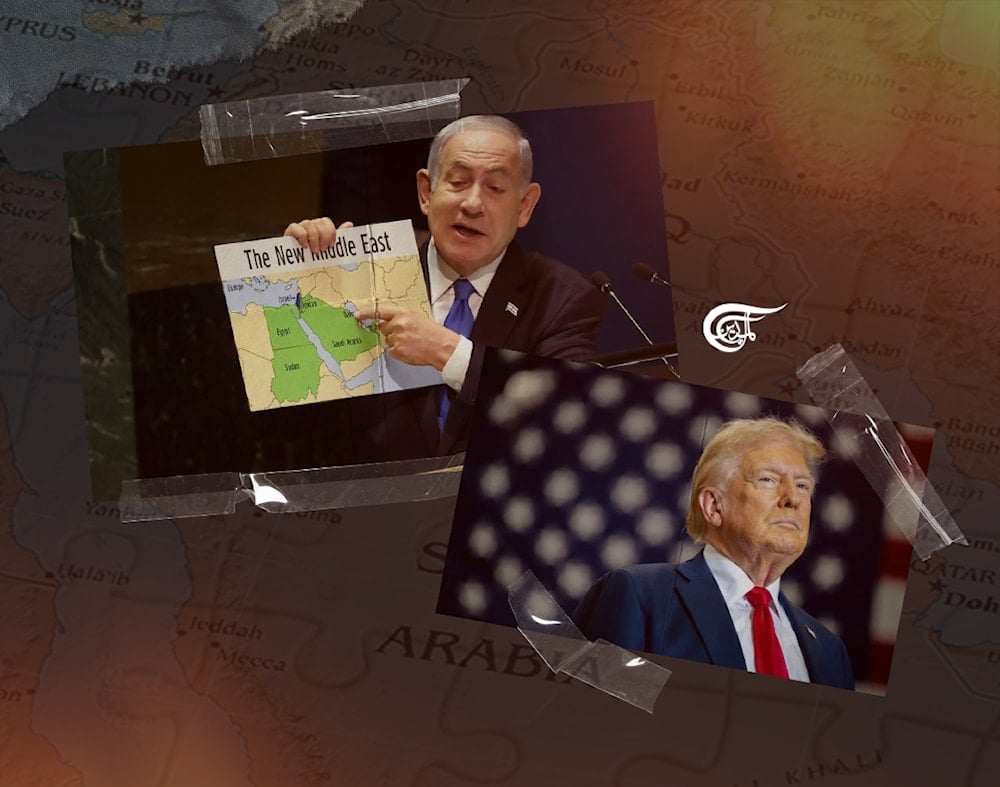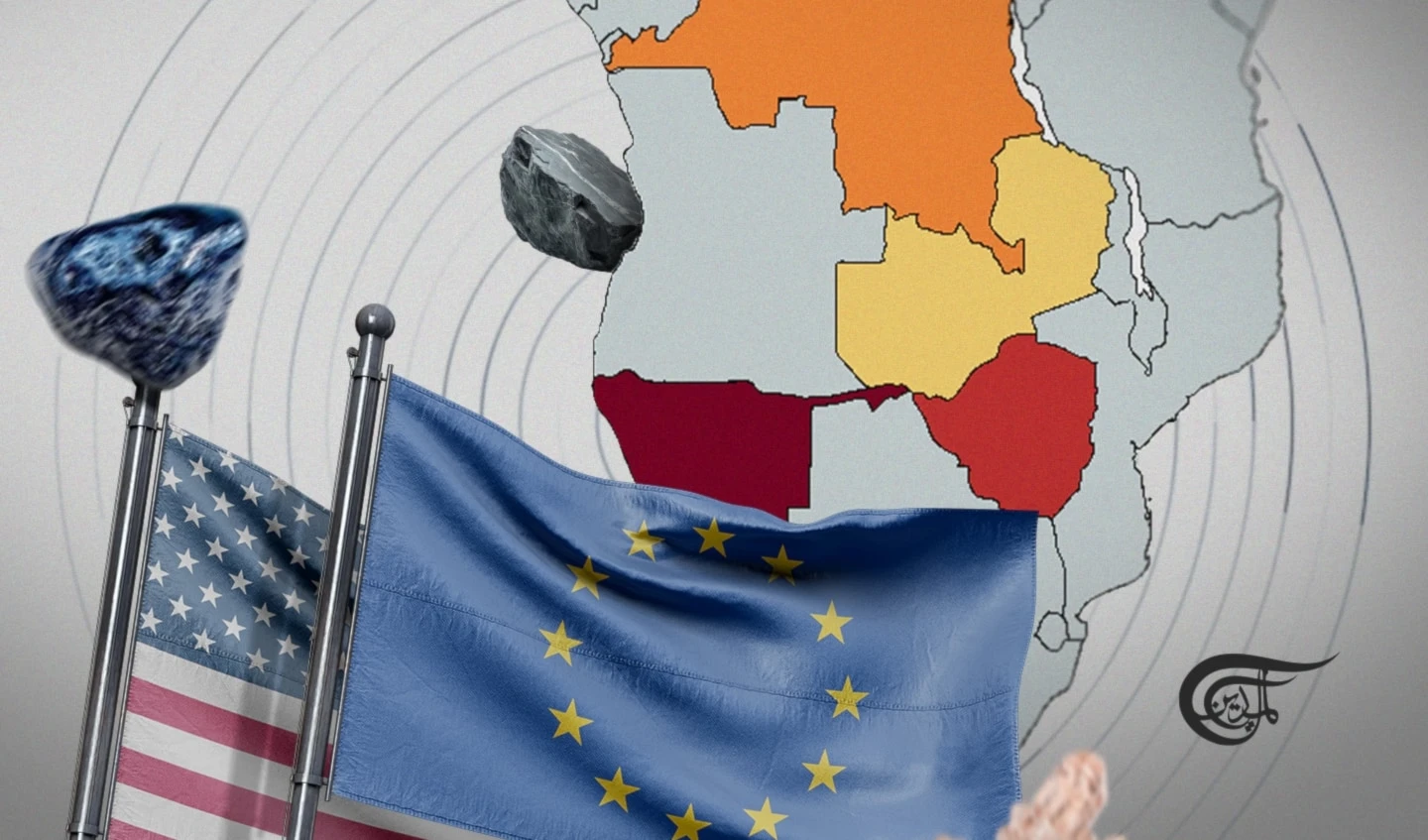Trump’s ‘New Middle East’ vision
Trump’s policies will not succeed, given the elements required to implement these policies are too large and uncontrollable.
-

Trump believes he can dictate his orders to these countries and execute the “evacuation project”. (Al Mayadeen English; Illustrated by Ali Al-Hadi Shmeis)
"[The Israeli occupation entity] is so tiny and needs fattening up". This was a statement made by Trump during the late days of his election campaign. Netanyahu had announced ‘Plan A’ at the UN, calling it the “New Middle East”, which Netanyahu believed was within reach after successfully targeting Resistance leaders. Trump was prepared to endorse Netanyahu’s territorial expansion under this plan, however ‘Plan A’ failed at the front-line villages in southern Lebanon.
Trump then moved to ‘Plan B’ for the Middle East, ordering an end to the war in southern Lebanon and Gaza. He dislikes prolonged conflicts and realized the entity was incapable of achieving victory despite its stubbornness. Instead of “fattening up” the entity through ‘Plan A’, Trump shifted to a strategy of emptying Palestinians from the Palestinian territory, in order to manage the Jewish demographic so it is always a majority. He contacted the King of Jordan and the President of Egypt for this purpose.
Trump believes he can dictate his orders to these countries and execute the “evacuation project”. However, relocating them to Jordan can lead to real instability, even potential overthrow. Therefore, all America can do is encourage voluntary immigration. For this reason, they have also sought to create unbearable conditions in Gaza and the West Bank to further this objective. However, the Palestinians have proven steadfast in their land and refuse to leave no matter the hardships.
Trump's new Middle East strategy aims to rescue "Israel" from its current predicament. It includes Saudi Arabia’s official recognition of "Israel" and the establishment of diplomatic relations. However, this would just be the case of relations going from being under to over the table. The Abraham Accords did not stop October 7th from occurring and proved that normalisation does not change the equation. It has become clear no scheme or collaborators will make Palestine disappear.
In his imagination, Trump seeks to restore American unipolarity by control over the economy, SWIFT, hegemony of the dollar, in addition to sanctions. Trump's plan envisions large-scale investments in the Middle East. This includes exploiting “Mediterranean oil and beaches” and turning Gaza into a booming economic hub. Gaza would be like a “new Hong Kong in the Middle East”, with American companies at its core.
Furthermore, Trump threatened BRICS nations against launching a new currency for trade, warning them of 100% tariffs. Many BRICS-affiliated nations, including Saudi Arabia and Egypt, are from West Asia. He aims to separate Saudi Arabia as a financial power and Egypt as a consumer market from BRICS' monetary ambitions. Trump also plans to block Chinese investments and the Belt and Road Initiative by ensuring a strong Western presence in the region.
The US and its companies may potentially enter Syria for reconstruction and investment. Trump considers Syria’s new rulers to be terrorists. Plan A for Syria could likely consist of pushing for a government made up of individuals not labelled as terrorists. This could include bringing them in via the Gulf states rather than Turkiye. Once this transition is complete and a civilian, Gulf-friendly regime is established in Syria, a peace agreement with "Israel" can follow. This government in Syria would likely be a product of Syria undergoing a period of unrest, followed by reconciliation. The country will remain de facto divided until full stabilization is achieved. Trump will unlikely withdraw US forces unless they are under threat.
If chaos and conflict persist, Plan B for Syria under Trump could involve partitioning the country into four zones: One controlled by Turkiye another by the U.S. via Kurdish forces, a third under the Israeli occupation entity, and a fourth remaining a lawless, chaotic zone.
The US zone will be in the Euphrates region, including Raqqa, al-Hasakah, and Deir Ezzor, with Kurdish control. Turkiye’s zone will be fully controlled by Ankara, covering Aleppo and Hama. The Israeli occupation entity will influence areas it has entered, extending from Golan to Daraa. A coastal Alawite region could emerge, possibly under French or Turkish oversight.
Regarding Iran, Trump will attempt dialogue under American terms. Negotiations will take a long time and ultimately fail. When there are two differing lines, with Iran wanting to expel American imperialism from the region and America wanting to bring about ‘regime change’ in Iran, there is nothing for both parties to unite on, therefore no conclusion will be reached.
All of Trump's policies in the region are doomed to collapse. He might consider a full regional withdrawal, replacing military presence with maximum sanctions, diplomatic isolation, and pressure on all parties linked to Iran. This will only however strengthen the China-Russia-Iran alliance, significantly weakening US dominance in the region. Trump’s policies will not succeed, given the elements required to implement these policies are too large and uncontrollable. There also remains a regional Axis that strongly rejects these plans in their entirety.

 Batool Subeiti
Batool Subeiti
 5 Min Read
5 Min Read











